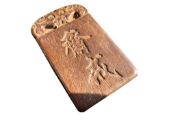Strict
Whenever the days of abstinence were at hand, large wooden boards with the same inscription would be hung in all palace buildings. As a final reminder, small copper statues would be placed throughout the palace to serve as an admonition to solemnly observe abstinence. The Qing had adopted this custom from its Ming predecessor. Ijishvn Dasan Khan declared in 1651:
Before any sacrifices to Heaven, Earth, at the Ancestral Temple, at the Altar to the Gods of Earth and Grain, abstinence is to be observed for three days, according to custom. Before a sacrifice to previous emperors, abstinence is to be observed for two days, according to custom. During these five days of sacrifice, whether the Emperor performs them himself or an official respectfully fills in, they shall all hang the abstinence tablet at the Hall of Supreme Harmony and place the copper statues. Every yamen should also display the abstinence tablet.
Many of these ‘copper men’ 銅人 are still extant. Conspicuously, their hands are always in the same position. The Ming Emperor Hongwu tells us why as he orders the copper statues to be cast:
The mind of men is impermanent, then taking hold, then letting go. It must be admonished so that it does not let loose anymore. Thus, I ordered the Ministry of Rites to cast bronze statues, standing one foot and five thumbs tall, grasping a simple strip of paper in their hands. Before major sacrifices, it should be written on the paper strip that ‘Abstinence is observed for three days!’ Before the regular sacrifices, it should be written on the paper strip that ‘Abstinence is observed for two days!
So, the copper men we have left today are actually lacking their defining attribute: a paper strip that informs anyone who perceives them that the time to observe abstinence in preparation for an imperial ritual had come.

